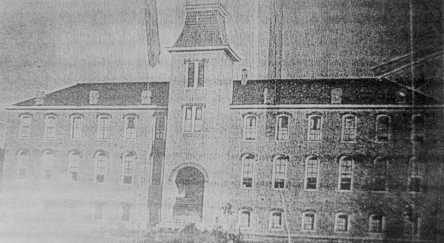SWIFT MEMORIAL COLLEGE (1883-1955)

William Henderson Franklin, one of the first African-American
graduates of Maryville College, was born in 1852 in Knoxville, Tennessee,
to slave parents Henderson and Elizabeth (Bates) Franklin. He received
his early education in the city's church-operated academies. Later, he
was graduated from Maryville College, one of the few white schools of higher
learning in the state that accepted students of African heritage. After
completing the required course work at Maryville College, Franklin entered
Lane Theological Seminary in Cincinnati, Ohio, and was graduated in 1883.
Subsequent to his graduation, Franklin was sent to Rogersville, Tennessee,
to establish a Presbyterian Church and assist the city's African-American
populace. The Reverend Franklin became pastor of St. Marks Presbyterian
Church in Rogersville (Hawkins County).
The same year he arrived in Rogersville, the Reverend Franklin established
Swift Memorial Institute and served as its principal and later as its president.
For ten years, classes were conducted in the church. Ten years after the
school's founding, the academy's first structure was actualized and named
in honor of the Reverend Elijah E. Swift, president of the Board of Missions
for Freedmen and pastor of the First Presbyterian Church of Pennsylvania.
In 1901, because the state's legislative body enacted a statute that closed
Maryville College's doors to African Americans, the school's board of trustees
voted to convey $25,000 of its endowment to Swift Memorial Institute. The
$25,000 transfer carried with it the prerequisite that the Board of Missions
for Freedmen erect a dormitory for male students and that the educational
institution be elevated to a four-year college. Through the endeavors of
Dr. Mary E. Holmes of Rockford, Illinois, and friends of Dr. Swift, the
Freedmen's Board built a three-story men's dormitory in 1903. A year later,
Swift Memorial Institute became Swift Memorial College offering a four-year
curriculum. By 1913, the women's dormitory was inadequate to meet the school's
needs, and two wings were added to the main building for dormitory use.
Under President Franklin's leadership, the school experienced growth
and prosperity. Franklin retired at the end of the 1926 academic year,
and he was succeeded by the Reverend Dr. C. E. Tucker, pastor of the Leonard
Street Presbyterian Church in Chattanooga, Tennessee. During the beginning
of Dr. Tucker's administration, the Tennessee Board of Education began
its program of evaluating all educational institutions. The state board
gave Swift credit for only one year of its four-year curriculum. Dr. Turner
began the process of reorganizing the school. Three years later, the curriculum
was standardized and two years of fully accredited college courses were
offered. Swift Memorial College became Swift Memorial Junior College. As
a junior college, the school flourished and continued its mission of providing
an education to students from Tennessee and other southern states.
After ten years of untiring service, Tucker retired at the end of 1935-36
school year and was succeeded by Dr. Hargrave, head of the English and
education departments. Dr. Hargrave retired in 1941 and was followed by
Robert E. Lee, who had served the college since 1926 as a teacher, coach,
and dean. Under his management, many changes were implemented, including
the addition of the Industrial Arts Department, a gymnasium, a home economics
cottage, and an expanded library.
During the 1940s and 1950s, the National Board of Missions began reassessing
the feasibility of operating the twenty schools located in the South. The
National Board of Missions for Freedmen discontinued its support for Swift
Memorial in 1952. However, with assistance from the local board of directors
and from funds obtained from public sources, receipts from students, and
gifts from alumni and friends, Lee was able to keep the school operational
until 1955.
In 1955, Swift Memorial Junior College closed. The boys' dormitory was
used by the Hawkins County Board of Education as a public high school,
and William T. Blevins, a Swift alumnus of Rogersville, was hired as principal.
The building was used as a high school until 1964, when Hawkins County
schools were desegregated.


